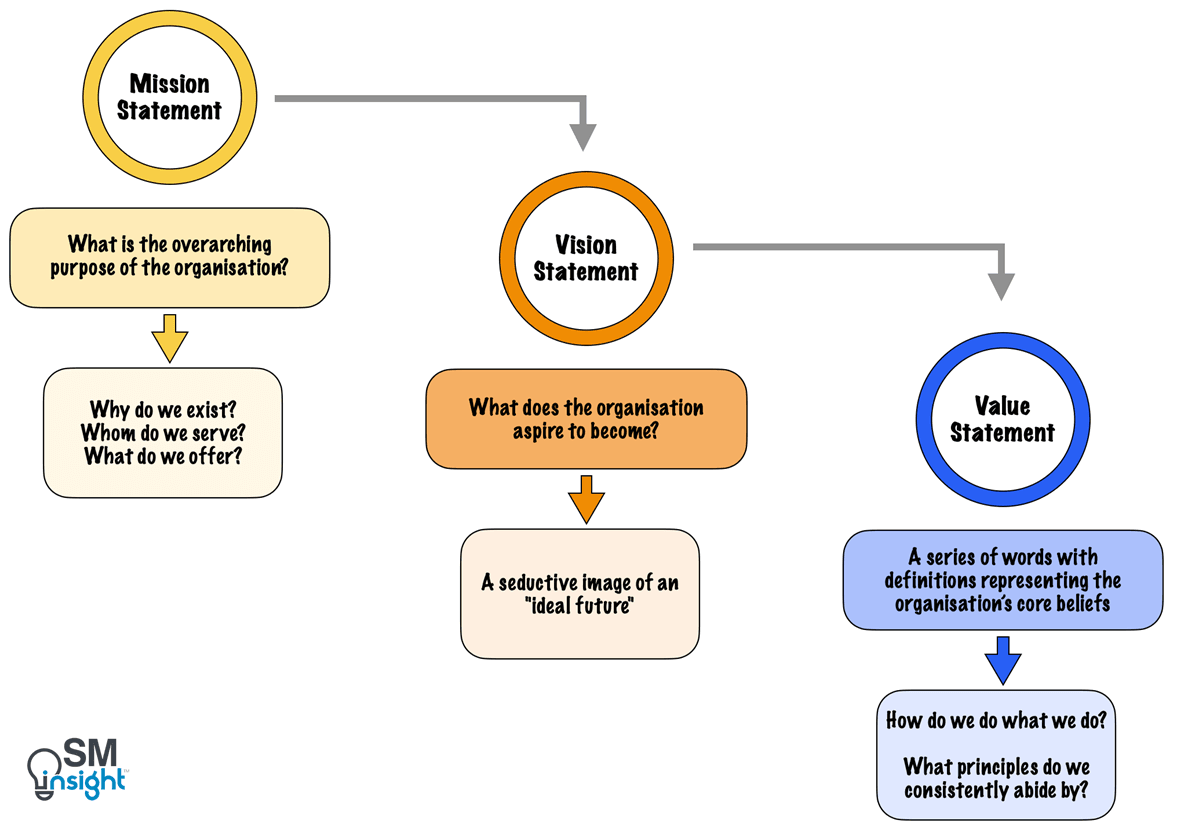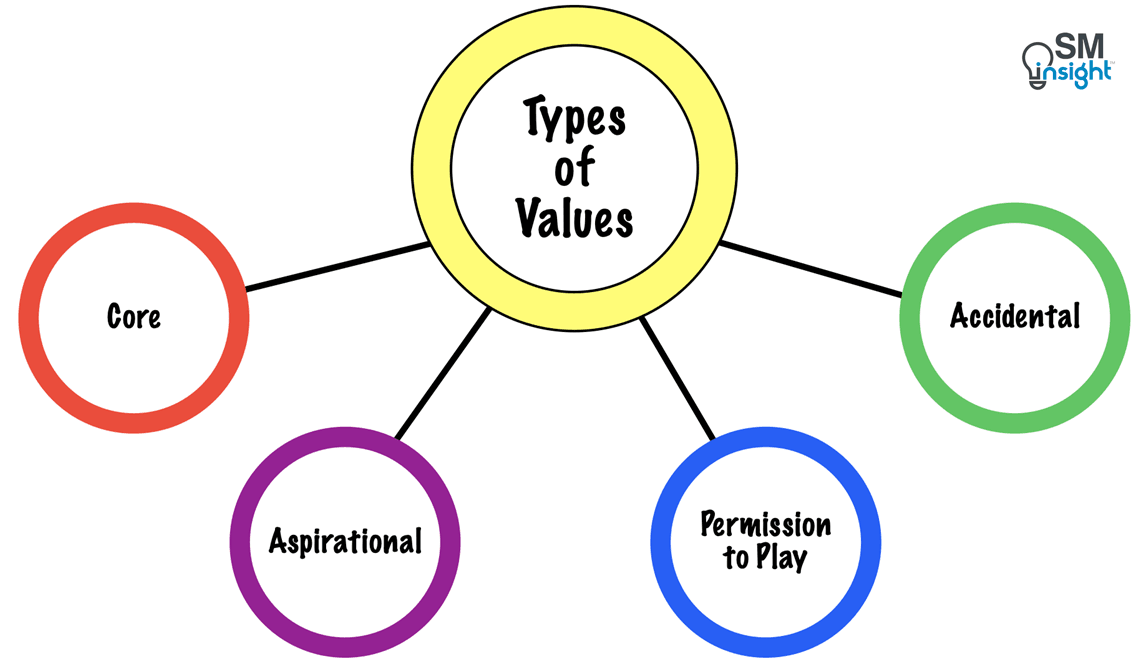Every organization needs a mission, a vision, and a set of values to develop a great culture. Its mission is the purpose and reason for being. Its vision is its aspiration for itself. Its values (or virtues) are the way it commits to working.

What is a Value Statement
A value statement defines the foundational beliefs that a company stands for. It makes them explicit and communicates how the organization does what it does and the principles it commits to consistently abide by.
Values set a company apart from the competition by clarifying its identity and serving as a rallying point for employees. While a vision articulates a company’s purpose, values offer a set of guidelines on the behaviors and mindsets needed to achieve that vision.
Most large companies today have a defined value statement.
McKinsey & Company, for example, has an articulated set of values that involve the way the firm vows to serve clients, treat colleagues, and uphold professional standards [1]. Google maintains its values embedded into its philosophy of “ten things we know to be true” [2] [3].
Values of most companies revolve around a few topics such as employees, customers, professionalism, etc., but what truly matters is their authenticity more than originality.
Why have a values statement
The push to create value statements grows out of the radical shift in how and with whom people interact. Until the 20th century, and before automobiles became widely accessible, the communities that people lived with were the same as they worked with.
Consequently, there was little disconnect between the values baked into the local community and those of the organization. Since community and culture are built around what people have in common, core values were shared and naturally understood.
Today’s organizations, however, are vastly different. The modern workforce has fragmented identities where people are nominated for employment by impersonal algorithms. They express themselves on social media and can live hundreds or thousands of miles from their birthplaces.
Unlike in the past, when a group of new hires walks into a modern workplace, they may have nothing in common beyond their skills. In a workplace where people could essentially be strangers to each other, value statements have a greater goal of celebrating diversity and bringing employees together to achieve a common goal.
Values before the value statement
Most companies today tout their values publicly – values that too often stand for nothing but a desire to be politically correct.
For example, the values “Communication. Respect. Integrity. Excellence.” may sound pretty good, but these were the values of Enron – the company that went through a scandalous collapse in late 2001 and has become a byword for all that was wrong with American business at the start of this century [4] [5].
Coming up with strong values and sticking to them is hard. This is because practizing values inflicts pain. They can make some employees feel like outcasts and limit an organization’s strategic and operational freedom. They can constrain people’s behavior and can leave executives open to heavy criticism for even minor violations. They demand constant vigilance.
Organizations serious about creating and implementing values must follow the four basic imperatives:
Identify the four types of values
There are four types of values. To maintain clarity, companies must not mix one with the other. This ensures people know what they’re talking about and what they’re trying to accomplish:

Core values
These are deeply ingrained principles that guide a company’s actions. They serve as cultural cornerstones and a source of distinctiveness. Core values are inherent and sacrosanct and must be maintained at all costs. They can never be compromised for convenience or short-term economic gain.
For example, trust is one of the core values of Ford Motor Company. During the pandemic, Ford put competition aside and partnered with GE Healthcare and 3M to assist in the production of health equipment.
The company also shifted its marketing focus from selling to relieving the stress of current customers. It stopped running ads promoting and replaced them with informational spots about a car payment relief program [7].
Aspirational values
These are values that a company needs to succeed but currently lacks. The need for aspirational values may arise to support a new strategy or to meet the requirements of a changing market or an industry.
Aspirational values need to be carefully managed to ensure that they are not confused with (or contradict) the core values. It is important to decide what matters the most.
For example, a company that adopts “hard work” and “dedication” as its core values may send confusing messages if it adds “work/life balance” as an aspirational value.
Aspirational values express what the company hopes to be. When defining them, it is a good practice to start with reality and gradually envision something grander as opposed to declaring something grand and suffering the consequences of not getting there.
Permission-to-play values
These are values that specify the minimum behavioral and social standards expected of any employee. Usually, such values tend to be the same across companies, particularly those working in the same region or industry. They don’t help distinguish a company from its competitors.
Permission-to-play values are sometimes mistaken for core values. For instance, a bank might define “integrity” as its core value while referencing policies that protect customer interests. This is a baseline expectation from any bank.
Unless it is willing to adopt unusually tough measures to demonstrate that it holds a higher standard of integrity than most of its competitors, “integrity” is a permission-to-play value, not a core one.
Accidental values
These are values that arise spontaneously and become important over time without being consciously cultivated by the organization’s leadership. They represent the shared beliefs, behaviors, and attributes in the workplace that evolve with time.
Accidental values cut to the heart of what a company’s culture is about by reflecting the common interests or personalities of the organization’s employees. They describe what it looks like to be a valued employee, and what it takes for each employee to work together for a common cause.
Every company has a handful of accidental values, though it may not realize them. These generally stem from two sources: its core values and its leadership behavior.
Accidental values can be both good and bad forces.
In Uber, for example, the core value of “toe-stepping” was originally intended to encourage employees not to be afraid of conflict. However, this ended up encouraging employees to engage in conflict in the workplace, a major detriment to their company culture [8].
Be authentic
Value statements are not marketing taglines. They must not be measured by the attention they receive, but by how authentic people perceive them to be. Adopting blandly nice ideals that fail to differentiate a company from its competitors is meaningless.
Values like “integrity”, “customer satisfaction” and “teamwork”, for example, look good in a value statement but hardly provide a distinct blueprint to shape employee behavior. They are used by most. Not only do they fail to set a company apart from competitors, but they rather make them fade into the crowd.
A company’s values must be extracted, lived, and felt – not scripted. They must stem from what is shared and often unwritten; they must create identity and belonging while acting as a compass.
Customers and other stakeholders expect continual evidence of what a company stands for and how it sustains the values espoused across its businesses. If its values are authentic, this becomes a natural process rather than a conscious effort.
Ownership is more important than consensus
In several companies, value initiatives are managed by HR, who use them as an excuse for an inclusive feel-good effort. The typical approach is to roll out employee surveys and hold town meetings to gather inputs and build consensus.
But values initiatives are less about building consensus and more about imposing a set of fundamental, strategically sound beliefs on a broad group of people.
Consensus is bad for two reasons:
First, it integrates suggestions from some of the employees who probably don’t belong at the company in the first place. And second, it creates the false impression that all inputs are equally valuable.
Value initiatives must be owned by the leadership.
The best value efforts are driven by small teams which include the CEO, founders (if they are still with the company), and a handful of key employees. Such a team should discuss values over several months while allowing enough time to reflect on how the standards will play out within the company.
A good values program is never rushed. It is important to arrive at a statement that works.
Integrate values into every process
For values to take hold of a company, they must be integrated into every employee-related process – hiring policies, performance management systems, criteria for promotions and rewards, and even dismissal policies.
Employees must realize that a company’s values are more than just words. From the first interview to the last day of work, they must be reminded that core values form the basis for every decision the company makes. Leadership should send a clear message that when it comes to core values, there is no room for compromise.
Developing and implementing a solid values system is hard work. However, for those willing to put in the time and energy, differentiation and a competitive edge are consequences.
Developing a value statement
A company’s value statement informs its stakeholders – board members, shareholders, customers, and the entire community about what the company believes to be the most important. It declares – “When you do business with us, this is what you are assured to get.”
Hence, the best way to create a value statement is to look at existing values and articulate them in a meaningful way. The process broadly consists of the following steps:
Establish a team
The team responsible for formulating the value statement should comprise individuals from leadership as well as the working level. They must have a deep understanding of the company, its culture, and the business. Members must have more than a passing interest in the business and must be truly committed to the company’s success.
Ask questions
- What does the business stand for?
- Do employees stand for the same thing? What’s important to them?
- What is important to shareholders and clients?
- What behaviors do we value?
- What behaviors do we deem unacceptable?
- How do we conduct ourselves in a business setting?
- How do we decide who we’ll do business with?
- What are some qualities we admire in other businesses? In other people?
- What impact do we want to have on the community?
As the team brainstorms along these lines, certain themes will emerge, and the underlying values will gradually reveal themself.
Narrow down
While the list of values could be long, a value statement should typically include between 3 to 12 key values. Hence it is necessary to focus on a few core values.
The most obvious way to do this is by identifying values that came up multiple times. Sometimes, a deeper discussion may be required to select values that truly matter to the organization. In case of debate, it is important to let the conversation go on until a natural resting place emerges.
Associate values with distinct words and use a unique style
For a company’s values to be unique, the choice of words and how it describes the values must be distinctive. Most corporations’ values incorporate similar words and ideas.
For example, research shows that 90% of value statements reference ethical behavior or use the word “integrity,” 88% mention commitment to customers, and 76% cite teamwork and trust [9].
If the core values are not expressed in distinct words and a unique style, employees are unlikely to pay attention to, much less care about values that seem commonplace and conventional.
Test the value statement
As a litmus test of whether a core value is unique, companies must ask: “Could another company claim this value as its own and live it out in the same way as we do?”
Several companies list “passion,” “innovation,” and “caring” in their value statement and live by them each day as they develop products and serve customers. But great value statements can do much more.
Zappos’s “Deliver WOW Through Service” is a great value statement. It captures the essence of the company’s personality and spirit, emphasizing both exceptional service and a commitment to exceeding customer expectations [10].
Sometimes, different organizations in the same industry can hold conflicting values.
For instance, a young tech start-up may adopt the phrase “just ship it,” in their value statement and prioritize speed over perfection, while companies like Google may emphasize the opposite with phrases such as “great just isn’t good enough” to prioritize their pursuit of excellence.
Both points of view are valid and valued by different organizations.
Hence, another effective method for testing values is to consider whether a company would adopt the opposite value as its own. If this is true, then the identified value can serve as a powerful distinguishing factor for the company.
Sources
1. “Our purpose, mission, and value”. McKinsey & Company, https://www.mckinsey.com/about-us/overview/our-purpose-mission-and-values. Accessed 14 Oct 2024.
2. “New Google Parent Company Drops ‘Don’t Be Evil’ Motto”. Time, https://time.com/4060575/alphabet-google-dont-be-evil/. Accessed 14 Oct 2024.
3. “Ten things we know to be true”. Google, https://about.google/philosophy/. Accessed 14 Oct 2024.
4. “The fall of Enron”. The Economist, https://www.economist.com/books-and-arts/2005/04/14/the-fall-of-enron. Accessed 14 Oct 2024.
5. “Enron’s Vision (and Values) Thing”. New York Times, https://www.nytimes.com/2002/01/19/opinion/enron-s-vision-and-values-thing.html. Accessed 14 Oct 2024.
6. “Make Your Values Mean Something”. Patrick M. Lencioni (Harvard Business Review), https://hbr.org/2002/07/make-your-values-mean-something. Accessed 12 Oct 2024.
7. “The Humanity In Conducting Commerce: 9 Brands That Are Showing Their Core Values During The COVID-19 Crisis”. Forbes, https://www.forbes.com/sites/pauljankowski/2020/04/15/9-brands-that-are-showing-their-core-values-during-the-covid-19-crisis-the-humanity-in-conducting-commerce/. Accessed 17 Oct 2024.
8. “Uber’s rotten culture has spread — here’s how to stop it”. Financial Times, https://www.ft.com/content/95e5a172-51a9-11e7-a1f2-db19572361bb. Accessed 17 Oct 2024.
9. “Ban These 5 Words From Your Corporate Values Statement”. HBR, https://hbr.org/2018/02/ban-these-5-words-from-your-corporate-values-statement. Accessed 18 Oct 2024.
10. “How Zappos Infuses Culture Using Core Values”. Tony Hsieh (HBR), https://hbr.org/2010/05/how-zappos-infuses-culture-using-core-values. Accessed 18 Oct 2024.
11. “It’s Time to Take a Fresh Look at Your Company’s Values”. John Coleman (Harvard Business Review), https://hbr.org/2022/03/its-time-to-take-a-fresh-look-at-your-companys-values. Accessed 12 Oct 2024.
12. “HBR Guide to Crafting Your Purpose”. John Coleman, https://store.hbr.org/product/hbr-guide-to-crafting-your-purpose/10401. Accessed 12 Oct 2024.
13. “Purpose: Shifting from why to how”. McKinsey & Company, https://www.mckinsey.com/capabilities/people-and-organizational-performance/our-insights/purpose-shifting-from-why-to-how. Accessed 12 Oct 2024.
14. “Six Components of a Great Corporate Culture”. John Coleman (Harvard Business Review), https://hbr.org/2013/05/six-components-of-culture. Accessed 14 Oct 2024.
15. “Rethinking the Value of Core Values”. Forbes, https://www.forbes.com/sites/curtsteinhorst/2019/10/17/rethinking-the-value-of-core-values/. Accessed 14 Oct 2024.
16. “3 Overused Company Values (And How To Make Yours Stand Out)”. Forbes, https://www.forbes.com/sites/williamcraig/2016/04/19/3-overused-company-values-and-how-to-make-yours-stand-out/. Accessed 17 Oct 2024.
17. “How to follow in the footsteps of the world’s most authentic brands”. The CEO Magazine, https://www.theceomagazine.com/business/marketing/authentic-brands/. Accessed 18 Oct 2024.

